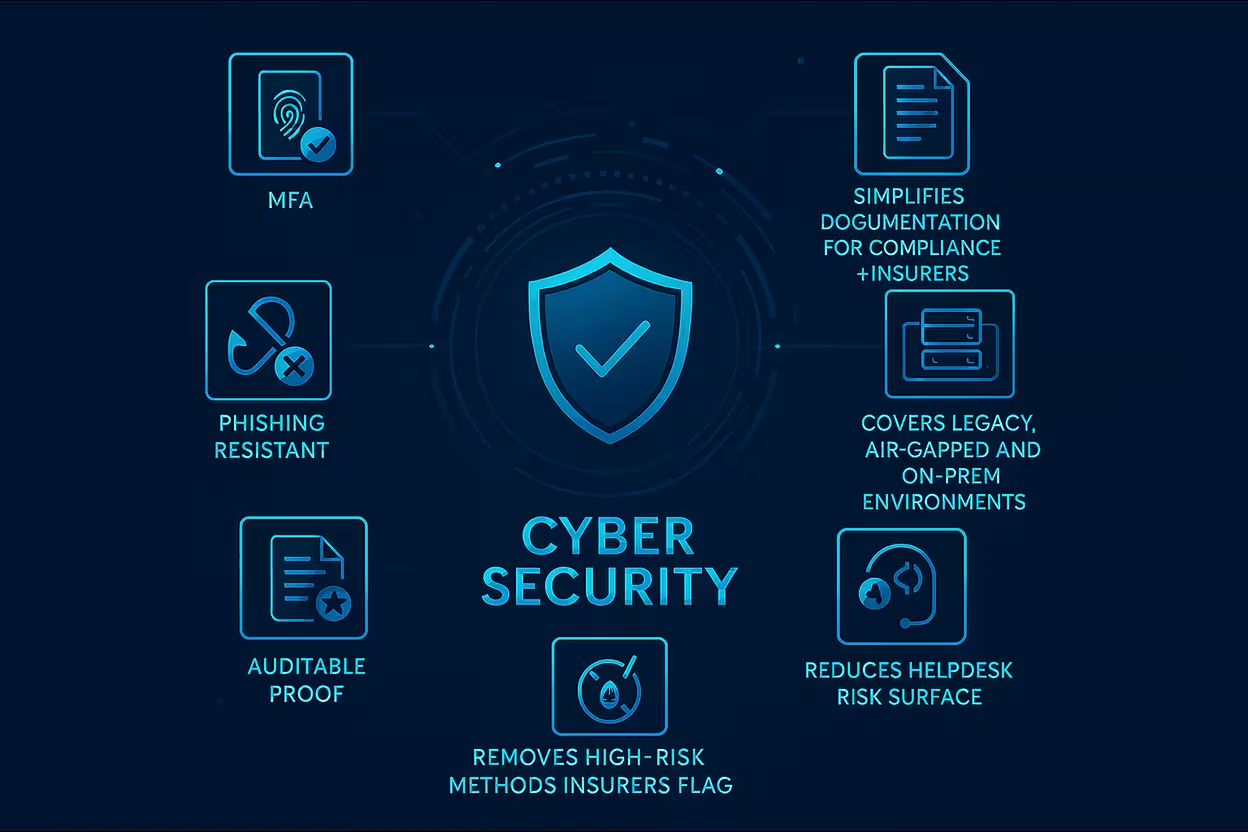Cyber Insurance Qualification Made Easy
Eliminate password risk, enforce phishing-resistant MFA everywhere, and give insurers the evidence they expect — all with Credenti.

How Credenti Supports Cyber Insurance Requirements
Cybersecurity insurers increasingly require proof of strong authentication controls, reduced credential risk, and operational maturity before issuing or renewing policies. Credenti directly aligns with these requirements, helping organizations qualify faster and often at lower premiums.
Below is the high-level positioning you can use:
1. Eliminates Password Risk — The #1 Factor in Insurance Underwriting
Insurance questionnaires ask about:
- MFA coverage
- Password policies
- Privileged access controls
- Account takeover prevention
Credenti replaces passwords entirely with mobile-based biometrics, badge tap (RFID/CAC/PIV-I), and QR-based MFA. This allows organizations to answer “Yes” to key insurer questions like:
- “Do you use phishing-resistant MFA?”
- “Is MFA enforced for all users?”
- “Do you minimize password exposure for employees?”
Insurers reward this with higher approval likelihood and reduced premiums.
2. Phishing-Resistant MFA Across All Users
Unlike partial MFA deployments, Credenti ensures full workforce coverage:
- Knowledge workers (mobile biometrics)
- Frontline workers without phones (badge tap or QR codes)
- Admins & privileged users
- Shared workstations and air-gapped environments
This provides complete MFA enforcement, something insurers frequently require but most organizations struggle to prove.
3. Provides Auditable Proof of Authentication Controls
Credenti provides:
- Detailed authentication logs
- Enrollment + identity verification records
- Device attestation
- MFA coverage reports
- Policy-based access controls
This reduces time spent compiling evidence for insurance audits and renewals.
4. Removes High-Risk Methods Insurers Flag
Credenti helps organizations eliminate or avoid:
- SMS MFA (high risk)
- Password resets (risky + expensive)
- Shared passwords in frontline environments
- Legacy systems with no MFA
Insurers increasingly decline or increase premiums for organizations still depending on those methods. Credenti allows you to confidently say you replaced them.
5. Covers Legacy, Air-Gapped, and On-Prem Environments
Insurance questionnaires usually ask:
- “Do all systems support MFA?”
- “Is MFA enforced for remote access?”
- “Do you enforce MFA on internal legacy systems?”
Most organizations must answer “No” due to:
- Offline systems
- Legacy apps
- Shared desktops
- Remote industrial or manufacturing environments
Credenti fixes that, enabling MFA everywhere — even offline.
6. Reduces Helpdesk Risk Surface (Password Reset Attacks)
Insurance underwriters factor in:
- Helpdesk access controls
- Password reset procedures
- Insider risk
With Credenti Recover, users reset accounts through identity verification — no helpdesk involvement, no social engineering risk. This strengthens compliance with insurer expectations around account lifecycle security.
7. Simplifies Documentation for Compliance + Insurers
Because Credenti centralizes:
- Authentication methods
- Enrollment
- Policy control
- Audit logs
…it gives customers a single set of evidence to hand insurers. This reduces the back-and-forth and removes gaps between IT teams.
Summary Positioning
Credenti helps organizations qualify for cyber insurance faster by eliminating passwords, enforcing phishing-resistant MFA everywhere, and providing the audit-ready evidence insurers require.
Strengthen Your Insurance Controls with Credenti
See how passwordless MFA and secure recovery reduce your underwriting risk.








